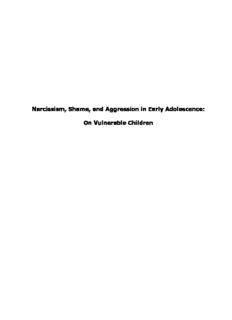
Narcissism, Shame, and Aggression in Early - VU-DARE Home PDF
Preview Narcissism, Shame, and Aggression in Early - VU-DARE Home
Narcissism, Shame, and Aggression in Early Adolescence: On Vulnerable Children ISBN/EAN 978-90-9021594-5 ©2007 PI Research Duivendrecht Printed by Reprografie, Vrije Universiteit, Amsterdam Distributed by PI Research, Postbus 366, 1115 ZH Duivendrecht (+31 20 7745650) All rights reserved VRIJE UNIVERSITEIT Narcissism, Shame, and Aggression in Early Adolescence: On Vulnerable Children ACADEMISCH PROEFSCHRIFT ter verkrijging van de graad Doctor aan de Vrije Universiteit Amsterdam, op gezag van de rector magnificus prof.dr. L.M. Bouter, in het openbaar te verdedigen ten overstaan van de promotiecommissie van de faculteit der Psychologie en Pedagogiek op dinsdag 27 februari 2007 om 15.45 uur in het auditorium van de universiteit, De Boelelaan 1105 door Sander Clement Emiel Thomaes geboren te ‘s-Hertogenbosch promotor: prof. dr. G.T.M. Stegge copromotoren: dr. T. Olthof prof. dr. B.J. Bushman Contents 1 General Introduction 7 2 Development and Validation of the Childhood Narcissism Scale 25 3 Can Anger be Rooted in Shame? Narcissism and “Humiliated 55 Fury” in Early Adolescence 4 Anger and Aggression in the Face of Shame: The Role of Fragile 77 Positive Self-Esteem 5 Trumping Shame by Blasts of Noise: Narcissism, Self-Esteem, 99 Shame, and Aggression in Early Adolescence 6 General Discussion 115 References 133 Nederlandse Samenvatting 155 Dankwoord 161 7 1 General Introduction Aggressive behavior among youth is a quintessential problem to modern society. Violence and aggression are rated among the greatest concerns of the general public in Western countries (e.g., Berke, 1994; Centraal Bureau voor de Statistiek, 2006). Also, aggressive youth are at risk to a range of subsequent adjustment problems, such as school failure, substance use, and delinquency, as well as depression and anxiety (for reviews, see Dodge, Coie & Lynam, 2006; Loeber & Hay, 1997). Aggression can be broadly defined as any behavior intended to harm another person who wants to avoid the harm (Bushman & Thomaes, in press). Clearly, this definition allows for a broad range of behaviors to be labelled “aggressive”. A common, and in many ways useful practice is to distinguish aggressive behaviors along the extent to which they are emotionally motivated (Averill, 1982; Dodge, 1991; Hartup, 1974; Lorenz, 1966). Some aggressive behaviors are predominantly “cold-blooded”, premeditated, and instrumental attempts to do harm. One could think of some kid beating up a classmate for no reason other than being able to run away with the classmate’s desirable I-pod. Such behavior, usually labelled “proactive” or “instrumental” aggression, does not require any form of emotional arousal. Other aggressive behaviors are “hot-blooded”, affective responses to some threat or provocation. One could think of some other kid beating up a classmate after being provoked, frustrated, or humiliated by an insulting remark of the classmate. Emotional arousal likely is the key trigger to such aggressive behavior, usually labelled “reactive” or “hostile” aggression (e.g., Dodge, 1991; Vitaro & Brendgen, 2005). EMOTIONS AND AGGRESSION In the past one or two decades, aggression researchers have shown increased interest in the emotional processes that influence children to lash out aggressively. 8 1 │ General Introduction Emotion-focused aggression research is important because it furthers our understanding of the underlying processes by which reactive forms of aggression emerge. Insight in those processes is needed to facilitate improvement in aggression prevention and intervention programs. Indeed, the first evidence-based emotion-focused aggression interventions have already been successfully implemented (e.g., Lochman & Wells, 1996). Thus far, virtually all research in this field has focused on the emotion of anger. It was found, for example, that reactively aggressive children tend to experience frequent and intense anger in response to emotionally arousing events (e.g., Bohnert, Crnic, & Lim, 2003; Hubbard et al., 2002; Orobio de Castro, Merk, Koops, Veerman, & Bosch, 2005). In addition, reactively aggressive children have difficulties in understanding the causes of their angry feelings, suggesting that they are regularly overcome with episodes of emotional arousal that they find hard to read (Bohnert et al., 2003). Also, reactively aggressive children have difficulties in regulating the experience and expression of anger (e.g., Dearing et al., 2002; Eisenberg et al., 2001; Orobio de Castro et al., 2005; Snyder, Stoolmiller, Wilson, & Yamamoto, 2003). Together, this research has yielded important insights in the role of anger as immediate emotional trigger of children’s aggressive behavior. Much less is known, however, about the emotional contexts, and initial emotional processes that instigate children to get angry and aggressive. Consider the example of the kid that beats up his classmate after being insulted. It is fair to assume that the kid experienced anger at the moment he assaulted his classmate. It is equally fair to assume, however, that the kid experienced other negative emotions (e.g., humiliation or indignation) before that time, at the moment he was insulted. These emotions may well have set the stage for the boy’s emotion-laden outburst of aggression. Unfortunately, very little is known about the emotions that may be at the root of children’s aggression. Theoretically, this means that we have an incomplete view of the constellation of emotional processes that make children behave aggressively. Clinically, it means that we do not know how to dispel the initial emotional impetus of children’s aggression. Clinical
Description: